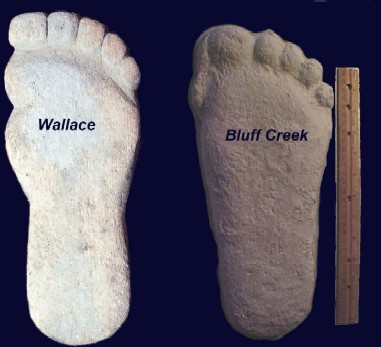
April 30, 2006
Reporter Cheryll Borgaard of the Longview Daily News in Washington State, on Sunday, April 30, 2006, has written a new article, entitled “Most Notorious — A legend or just elusive? Sasquatch keeps the world guessing.”

Her article is a typical overview piece, rather good in most parts. The news item talks about the late Grover Krantz estimating there are 2000 or so Sasquatch in the Pacific Northwest, local Longview men Randy Trusty and David Hart collecting Bigfoot track plaster casts in 1998, Robert Michael Pyle discussing skepticism but finding three prints, and the differences being expressed between Krantz and Pyle on the “kill-no kill” debate and the finding of bones. Probably a good introduction for people reading about Bigfoot on a Sunday morning for the first time.
In terms of a “media watch” of how reporters are still getting the Ray Wallace story wrong, Borgaard’s take is also incredibly typical, for she writes:
But for every small shred of proof, there are 100 hoaxes. The best known local Bigfoot trickster was the late Ray Wallace, a Toledo man whose family said helped create the Bigfoot legend. In 1958, Wallace made giant footprints at a work site in Humboldt County, Calif., that were reported by a local newspaper the next day. Wallace continued Bigfoot pranks when he returned to Washington, even having his wife dress up as one of the half-human wilderness creatures, relatives said.
The tracks found at the Ray Wallace construction site at Bluff Creek, California, appeared in two forms. Apparently an authentic Bigfoot left real prints, from August through October 1958 (and beyond). Sometime during that period, Ray and his associates allegedly started putting down another series of imprints from wooden fakes that looked much different than the actual Bigfoot footfalls.
To give the historical interpretation, as this article does, that the “giant footprints” were made and then immediately “reported by a local newspaper the next day” is totally incorrect, and leaves the wrong impression. After a few months of workers finding the tracks, finally taxidermist Bob Titmus taught Jerry Crew how to make a cast, to prove to people they weren’t crazy. It was after that, not until October, when Crew took that one now-famous “Bigfoot” cast to a local newspaper editor that the media took notice.
What did occur next, as far as Wallace continuing to create Bigfoot pranks back in Washington State, appears muddled. But certainly, years later, in the 1970s, Wallace films his wife in a bad gorilla suit. Wallace’s trickster moments did not happen in any great rush, and this filming not take place before the Patterson-Gimlin footage was taken in 1967. One of the biggest mistakes that often is found in Ray Wallace retellings, where reporters have blamed Wallace for filming the Patterson film, was avoided in today’s Borgaard article, thank goodness.
But Ray Crowe of the International Bigfoot Society in Hillsboro, Ore., said Wallace was a true believer and pulled some of the pranks to throw critics off the track.
Krantz admitted most sightings and footprints are hoaxes….Of the 75 accounts of Sasquatch sightings Krantz had heard about, he was convinced seven were authentic and another 33 probable.
Those are interesting thoughts to ponder from Crowe and Krantz. But Borgaard’s lasting impression about Ray Wallace and the start of the modern era of Bigfoot is problematic. How Bigfoot became a media giant in 1958 is a complex story, more than something about a little Wallace hoaxing and a newspaper mentioning a fake the “next day.” It just did not happen so simply.
Besides, why don’t reporters merely look at the photographs that compare the Wallace fake feet and the 1958 casts, an example of which is shown here?
To read the entire article, go here.
About Loren Coleman
Loren Coleman is one of the world’s leading cryptozoologists, some say “the” leading living cryptozoologist. Certainly, he is acknowledged as the current living American researcher and writer who has most popularized cryptozoology in the late 20th and early 21st centuries.
Starting his fieldwork and investigations in 1960, after traveling and trekking extensively in pursuit of cryptozoological mysteries, Coleman began writing to share his experiences in 1969. An honorary member of Ivan T. Sanderson’s Society for the Investigation of the Unexplained in the 1970s, Coleman has been bestowed with similar honorary memberships of the North Idaho College Cryptozoology Club in 1983, and in subsequent years, that of the British Columbia Scientific Cryptozoology Club, CryptoSafari International, and other international organizations. He was also a Life Member and Benefactor of the International Society of Cryptozoology (now-defunct).
Loren Coleman’s daily blog, as a member of the Cryptomundo Team, served as an ongoing avenue of communication for the ever-growing body of cryptozoo news from 2005 through 2013. He returned as an infrequent contributor beginning Halloween week of 2015.
Coleman is the founder in 2003, and current director of the International Cryptozoology Museum in Portland, Maine.
Filed under Artifacts, Bigfoot, Breaking News, Cryptotourism, CryptoZoo News, Cryptozoologists, Cryptozoology, Evidence, Eyewitness Accounts, Forensic Science, Media Appearances, Pop Culture, Public Forum, Reviews, Sasquatch